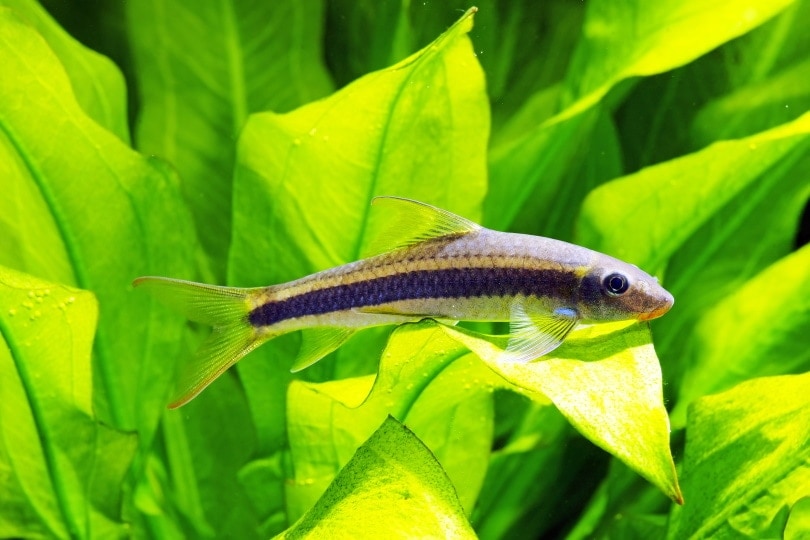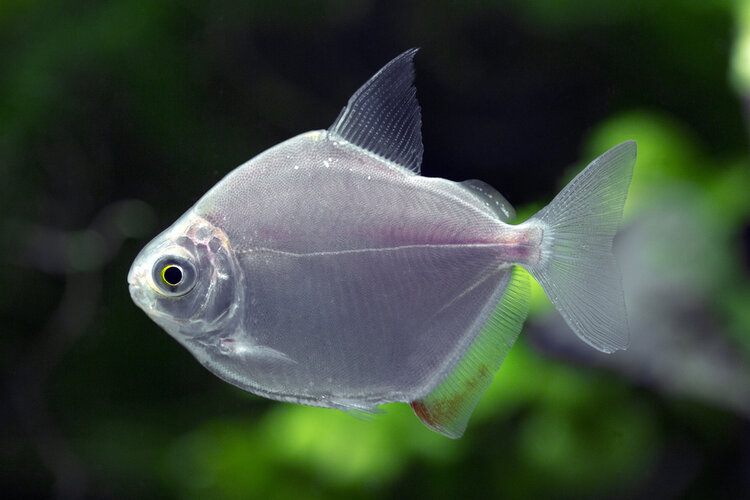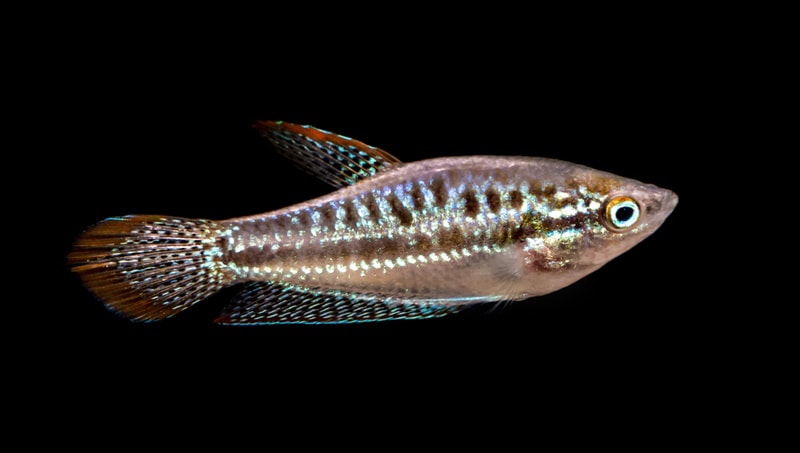20 Types of Aquarium Shrimp: Vet-Reviewed Pictures, Facts & Origins
Updated on
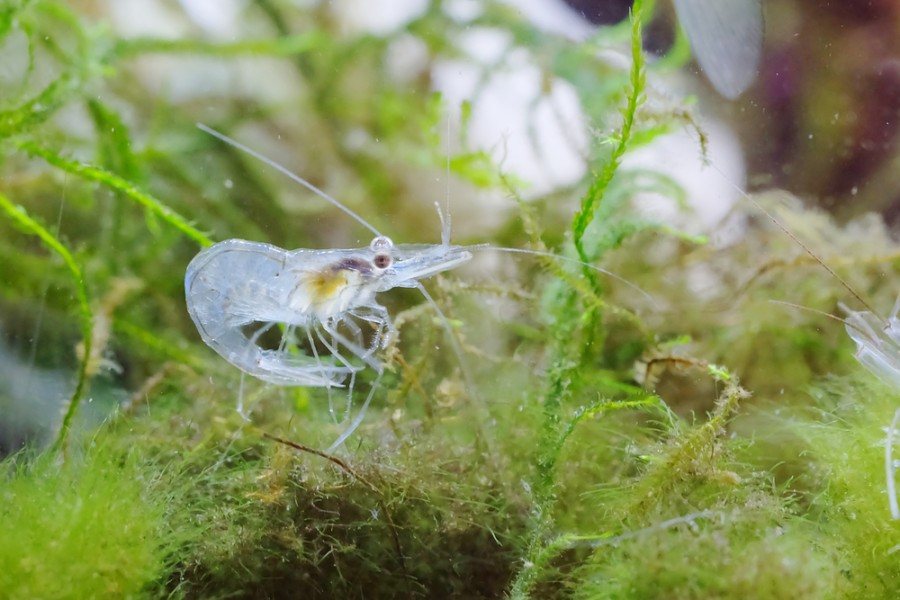
Shrimp can add interest to your tank while providing clean-up duty for algae and other debris. Many species are peaceful and will make excellent additions to a community aquarium. Availability varies, along with the varieties and colors. You can add shrimp to small, established tanks for the best success with these aquatic species.
Many shrimps in our round-up are smaller species. Their success with other fish depends on the species in question. Shrimp are prey for many fish, and a compatibility check is warranted prior to stocking them with fish. After all, shrimp don’t have much speed on their side to evade trouble. Our list includes many varieties of the same species so that you can choose the perfect fit.
The 20 Types of Aquarium Shrimp
1. Vampire Shrimp (Atya gabonensis)

| Difficulty | Intermediate |
| Availability | Limited |
| Temperament | Peaceful |
The vampire shrimp gets its name from its nocturnal lifestyle. It is also known as the African fan shrimp, African filter shrimp, African giant shrimp, blue rhino shrimp, Gabon shrimp, and the Cameroon fan shrimp.
It is a large species that is a contradiction to its name. After all, this crustacean can get up to 6 inches long. The species has the ability to change its coloration to fit its surroundings, providing excellent camouflage. Despite its size, it is a peaceful tank mate that doesn’t tolerate change in water parameters well. It’s native to West Africa and Eastern South America.
2. Bamboo Shrimp (Atyopsis moluccensis)

| Difficulty | Intermediate |
| Availability | Limited |
| Temperament | Peaceful |
The bamboo shrimp is a filter feeder that fares best in a tank with a moderate current that replicates its native habitat in Asia. It’s another large species of its type, although it is a peaceful tank mate. The concern is more because of the crustacean’s delicate fan. They prefer high-quality water conditions, making proper maintenance essential.
3. Amano Shrimp (Caridina multidentata or Caridina japonica)
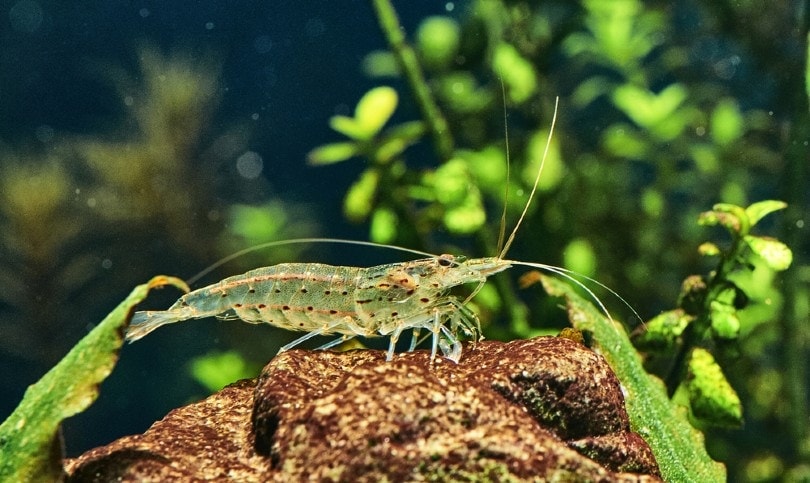
| Difficulty | Easy |
| Availability | Popular |
| Temperament | Peaceful and active |
The amano shrimp is an excellent beginner species that many credit with sparking the trend to add crustaceans to tanks for algae control. It is a native of the Eastern Asian wetlands. It is smaller than our previous entries, only reaching 2 inches long. Like many other shrimps, it is an omnivore. You should offer it sinking pellets, as they thrive better if offered nutrient-rich food rather than being relied on to scavenge for algae and other food.
4. Babaulti Shrimp (Caridina babaulti)

| Difficulty | Easy |
| Availability | Popular |
| Temperament | Peaceful and hardy |
The babaulti shrimp is a hardy variety that makes a good choice for beginners because of its relative adaptability to different water parameters. That said, it’s still considered relatively fragile (like other shrimp), and doesn’t adapt to a sudden change as well as some fish do. It’s a small crustacean, growing only up to 1 inch long. They are also excellent additions to planted aquariums because of their preference for vegetation. This shrimp will thrive in a well-maintained community tank.
5. Golden Bee Shrimp (Caridina cf. cantonensis)

| Difficulty | Intermediate |
| Availability | Uncommon |
| Temperament | Peaceful and active |
The golden bee shrimp has unique coloration, which its name suggests. It has a white outside shell and an orange/golden colored “fleshy” belly. It is an uncommon species, although its price is in line with other dwarf varieties if you can find them. It is native to China and Hong Kong. It’s a small crustacean that will fare best in a tank with little fish that won’t bother it. This species isn’t found in the wild. Instead, it is a product of selective breeding.
6. Black Pinto Shrimp (Caridina cantonensis)

| Difficulty | Intermediate |
| Availability | Popular |
| Temperament | Peaceful |
The black pinto shrimp is a riff on the crystal red shrimp with black markings. Each one is unique. It’s a Japanese variant that has gained quite the following. It too doesn’t exist in the wild. This crustacean prefers water that is slightly acidic and soft. It’s a peaceful creature that will actively clean up your tank. This shrimp grows to about 1.5 inches long.
7. Blue Bolt Shrimp (Caridina cantonensis)

| Difficulty | Intermediate to advanced |
| Availability | Limited and spendy |
| Temperament | Peaceful |
The Blue Bolt Shrimp is a striking creature that resembles an animal you’d expect to see in a marine tank. It’s not as common or well-known as other aquarium shrimp. It will likely cost more if you find one. This variant originated in Southern China and is not found in the wild. It prefers temperatures between 24 to 25 °C (75 to 77 °F), as at this temperature, its color is the most vibrant. Its color will fade if the water quality isn’t optimal, though.
8. Crystal Red Shrimp (Caridina cantonensis)

| Difficulty | Intermediate to advanced |
| Availability | Varies depending on the grade |
| Temperament | Peaceful |
The coloration of the crystal red shrimp resembles a candy cane. It will certainly attract attention in your tank. As the pattern may suggest, there are various grades of this variant based on the distribution of white and red. That can also affect the availability and price. This crustacean also does best in 24 to 25 °C (75 to 77 °F). The water should also be slightly acidic or neutral (7.0 pH).
9. Tangerine Tiger Shrimp (Caridina serrata var. “Tangerine Tiger”)

| Difficulty | Intermediate |
| Availability | Popular |
| Temperament | Peaceful |
The tangerine tiger shrimp is a far cry from its wild counterpart, discovered in Hong Kong in 1860. Selective breeding turned the drab brown shrimp into the beautiful crustacean it is today. Their colors will fade if the water quality isn’t ideal. This can also occur if your tank has a light-colored substrate. The latter is a reaction that often occurs in prey species to optimize camouflage.
10. Tiger Shrimp (Caridina cantonensis)
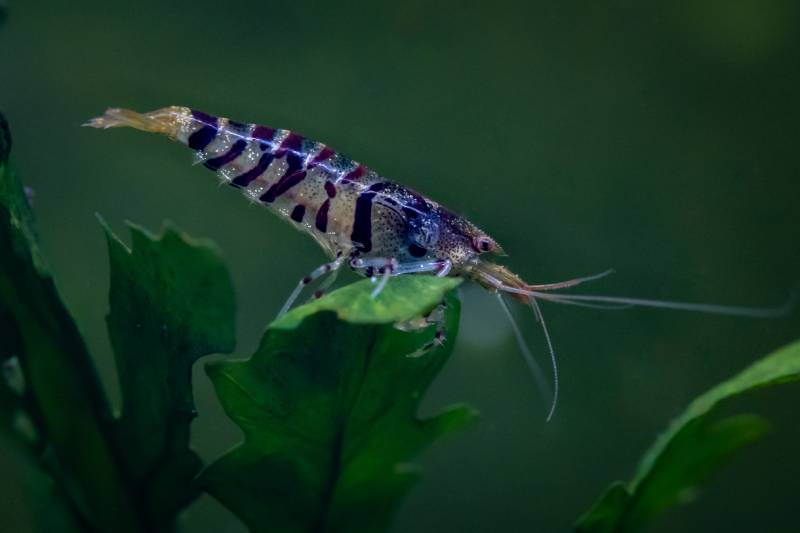
| Difficulty | Easy |
| Availability | Varies |
| Temperament | Easygoing and active |
The coloration of the tiger shrimp is the same as its name implies. It comes in many color variations, which can affect its price and availability. One of these variants is the wild type. This shrimp is native to Taiwan, where it is still found. Floating plants in your aquarium will provide welcome cover. The care of this crustacean is easy with the right conditions. Their ideal temperature is in the 21 to 26 °C (70 to 78 °F) range, though, like other variants of their species, their colors appear best in the 24 to 25 °C (75 to 77 °F) range.
11. Whisker Shrimp (Macrobrachium Lanchesteri)

| Difficulty | Easy to intermediate |
| Availability | Uncommon |
| Temperament | Aggressive |
The whisker shrimp is one of the few larger and aggressive species on our list. This crustacean can get up to 2.5 inches long. It is native to Southeastern Asia. It gets its name from its long front arms and nostrum. It is also a relatively long-lived species, with life spans of up to 5 years. It’s worth noting that they may attack other shrimp and small fish in your tank.
12. Blue Dream Shrimp (Neocaridina davidi)
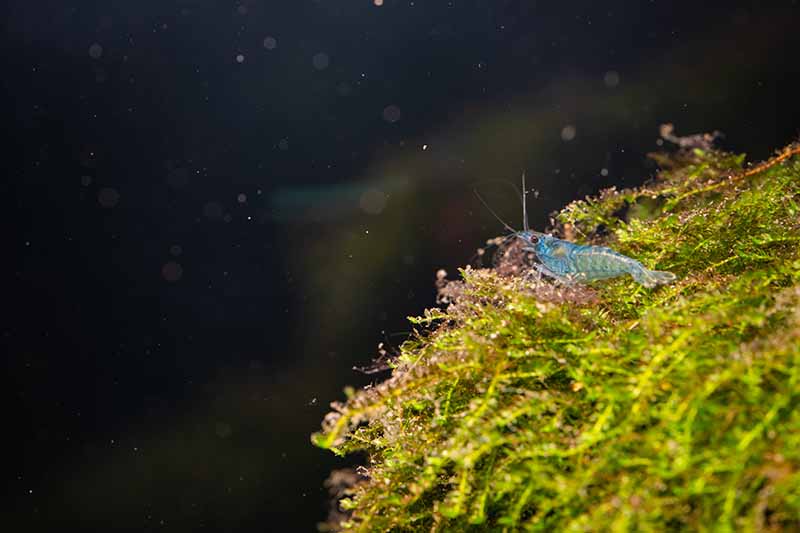
| Difficulty | Easy |
| Availability | Popular |
| Temperament | Peaceful |
The blue dream shrimp has one of the prettiest names for a crustacean. This variant is an import from Taiwan, although it doesn’t exist in the wild. It is in fact a variant of the cherry shrimp. You should keep your tank with a pH of 6.5-8, and a temperature of 14 to 29 °C (57–84 °F). They are most comfortable at 22 °C (72 °F). Like others on our round-up, its color will fade if your aquarium has a light-colored substrate. Dark gravel will make its color pop, though.
13. Chocolate Shrimp (Neocaridina davidi)

| Difficulty | Easy |
| Availability | Uncommon |
| Temperament | Peaceful |
The chocolate shrimp (another variant of the cherry shrimp) is unique because of its unusual coloration. It is a peaceful tank mate that is an active scavenger of whatever it can find. You’ll find tank-bred specimens at pet stores and online. It is easy to breed in captivity in high-quality water conditions. If you choose this route, you should keep them in an aquarium at least 10 gallons. The crustacean is indigenous to Taiwan.
14. Fire Red Cherry Shrimp (Neocaridina davidi)

| Difficulty | Easy |
| Availability | Popular |
| Temperament | Peaceful |
The fire red cherry shrimp is appropriately named for its striking color. It also makes it a popular variety for adding interest to a tank. You can put them in a community aquarium as long as you have hiding places for them and if the community aquarium doesn’t have any predators that would view these shrimp as food. They are easy to care for and are quite adaptable. You can breed them if you have a large tank.
If you’re housing them in a community setup, please note that some fish that don’t bother adult cherry shrimp might view baby shrimp as a snack. Dense plantations (such as moss) are recommended to offer baby cherry shrimp multiple hiding spots.
15. Green Jade Shrimp (Neocaridina heteropoda)

| Difficulty | Easy |
| Availability | Popular |
| Temperament | Peaceful |
The green jade shrimp is a variant of its wild counterpart (the cherry shrimp) that is native to the mountain streams of China and eastern Asia, although its conservation status is unknown. It’s a popular crustacean. While you can breed it in captivity, you may not get the color you expect. Nevertheless, it’s a peaceful tank mate and an excellent scavenger.
16. Red Rili Shrimp (Neocaridina davidi var. “Rili”)

| Difficulty | Easy |
| Availability | Popular |
| Temperament | Peaceful |
The red rili shrimp was originally selectively bred in Germany. The top of the crustacean is red with a white lower body. The result is striking. This variant prefers neutral to slightly alkaline water in cooler waters. It is a hardy and peaceful animal that will make short work of any algae in your aquarium. Wild populations exist in Taiwan but not of this color variety.
17. Snowball Shrimp (Neocaridina zhangjiajiensis “Snowball”)

| Difficulty | Easy |
| Availability | Popular |
| Temperament | Peaceful |
The snowball shrimp looks just like its name suggests. It is a hardy and adaptable variant and is able to tolerate temperatures ranging from 15–30 °C (59–86 °F) and a pH range of 6.5–8.0. However, consistency is key, and therefore, you should ensure that your water temperature and pH doesn’t fluctuate all the time to ensure your pet shrimps’ health. Anecdotally, they seem to do best at 22–23 °C (72–73 °F).
You should keep this crustacean with other peaceful tank mates. It is an excellent beginner variety because of its tolerance to varying conditions. This shrimp is also easy to breed in captivity as well.
18. Orange Pumpkin Spice Sakura Shrimp (Neocaridina heterpoda var. orange)

| Difficulty | Easy |
| Availability | Popular |
| Temperament | Peaceful |
With all things pumpkin spice, you just know there had to be a shrimp named after it, too. The orange pumpkin spice sakura shrimp is a color not found in nature. It is also sometimes known as the Sunkist orange shrimp (after the popular juice brand). It was originally selectively bred in Germany before the variant captured the attention of hobbyists worldwide. It is peaceful and the ideal tank mate in a community aquarium.
19. Yellow Shrimp (Neocaridina davidi var. “Yellow”)

| Difficulty | Easy |
| Availability | Popular |
| Temperament | Peaceful |
The yellow shrimp is like a breath of fresh air with its bright color. This variant is originally from Eastern Asia and Japan. Selective breeding brought this color to hobbyists. It thrives in stable tank conditions and is well-tolerant of less-than-ideal water chemistry. Nonetheless, we recommend testing it to ensure the ammonia and nitrite levels are in check.
20. Ghost Shrimp (Palaemonetes paludosus)

| Difficulty | Easy |
| Availability | Popular |
| Temperament | Peaceful |
The ghost shrimp is probably one of the first crustaceans of its kind to hit pet stores. Its popularity hasn’t waned since. It’s even sold as feeders in some places. It is the only North American species on our list. It is a hardy creature that is tolerant of varying water conditions. The shrimp is highly adaptable, tolerating temperatures from 15–27 °C (59–80.6 °F) and a pH from 6-8. They are nocturnal, though, and might not be overly visible during the day.
Conclusion
Shrimp are fascinating additions to an aquarium that pay for their keep quickly. They can keep algae under control and help maintain your tank’s water quality by removing debris. Nonetheless, they do need to be fed and cared for as well, and should not live exclusively off of scavenging opportunities. This is particularly true in newer aquariums where algae is minimal.
Many variants and species exist, giving you a plethora of choices. You may not have considered color when choosing species to put in your tank. However, these aquarium shrimp give you more to think about when setting it up.
Featured Image Credit: Nicholas Toh, Shutterstock


